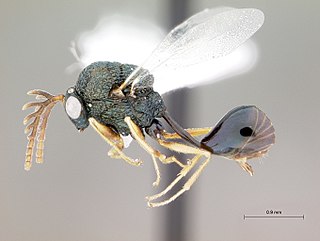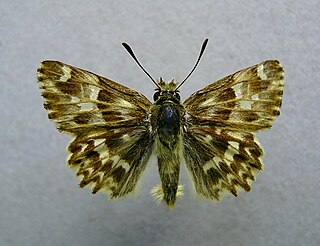
The Noctuidae, commonly known as owlet moths, cutworms or armyworms, are a family of moths. Taxonomically, they are considered the most controversial family in the superfamily Noctuoidea because many of the clades are constantly changing, along with the other families of the Noctuoidea. It was considered the largest family in Lepidoptera for a long time, but after regrouping Lymantriinae, Catocalinae and Calpinae within the family Erebidae, the latter holds this title now. Currently, Noctuidae is the second largest family in Noctuoidea, with about 1,089 genera and 11,772 species. This classification is still contingent, as more changes continue to appear between Noctuidae and Erebidae.

The Leptotyphlopidae are a family of snakes found in North America, South America, Africa and Asia. All are fossorial and adapted to burrowing, feeding on ants and termites. Two subfamilies are recognized.

Rhopalosomatidae is a family of Hymenoptera containing about 68 extant species in four genera that are found worldwide. Three fossil genera are known.

The Eucharitidae are a family of parasitic wasps. Eucharitid wasps are members of the superfamily Chalcidoidea and consist of four subfamilies: Akapalinae, Eucharitinae, Gollumiellinae, and Oraseminae. Most of the 42 genera and >400 species of Eucharitidae are members of the subfamilies Oraseminae and Eucharitinae, and are found in tropical regions of the world.

The Stephanidae, sometimes called crown wasps, are a family of parasitoid wasps. They are the only living members of the superfamily Stephanoidea. Stephanidae has at least 345 living species in 11 genera. The family is considered cosmopolitan in distribution, with the highest species concentrations in subtropical and moderate climate zones. Stephanidae also contain four extinct genera described from both compression fossils and inclusions in amber.

Dendropsophus is a genus of frogs in the family Hylidae. They are distributed in Central and South America, from southern Mexico to northern Argentina and Uruguay. They are sometimes known under the common name Fitzinger neotropical treefrogs or yellow treefrogs

Dryinidae is a cosmopolitan family of solitary wasps. Its name comes from the Greek drys for oak: Latreille named the type genus Dryinus because the first species was collected on an oak tree in Spain. The larvae are parasitoids of the nymphs and adults of Auchenorrhyncha. Dryinidae comprises over 1900 described species, distributed in 11 extant subfamilies and 57 genera.

Muschampia lavatherae, the marbled skipper, is a butterfly of the family Hesperiidae. It is found from the Rhine Rift Valley in central Germany up to North Africa and from south-eastern France up to Anatolia.

Cryptotympanini is a tribe of cicadas in the family Cicadidae. They are found in the Nearctic, Palearctic, Indomalaya, Oceania, and Afrotropics.

Eristalini is a tribe of hoverflies. Several species are well-known honeybee mimics, such as the drone fly Eristalis tenax, while other genera such as Helophilus and Parhelophilus exhibit wasp-like patterns of yellow and black stripes, both strategies to avoid predation by visual predators such as birds.

Tessaratomidae is a family of true bugs. It contains about 240 species of large bugs divided into 3 subfamilies and 56 genera.

The Pompilinae are a subfamily of the spider wasp family, Pompilidae, the species of which lay their eggs on the paralyzed bodies of their prey.

The Pepsinae are a subfamily of the spider wasp family, Pompilidae, including the two genera of large tarantula hawks, as well as many genera of smaller species.

Cynipini is a tribe of gall wasps. These insects induce galls in plants of the beech and oak family, Fagaceae. They are known commonly as the oak gall wasps. It is the largest cynipid tribe, with about 936 to 1000 recognized species, most of which are associated with oaks. The tribe is mainly native to the Holarctic.

Epictinae are a subfamily of snakes found in the New World and equatorial Africa. Members of this subfamily tend to have short, thick tails, and the fewest subcaudal scales. It comprises two tribes, three subtribes, ten genera, and 86 species.

The Thynnidae are a family of large, solitary wasps whose larvae are almost universally parasitoids of various beetle larvae, especially those in the superfamily Scarabaeoidea. Until recently, the constituents of this family were classified in the family Tiphiidae, but multiple studies have independently confirmed that thynnids are a separate lineage.

Detalik is a genus of jumping spiders, consisting of four species. The genus was circumscribed in 2021 by Wanda Wesołowska, along with descriptions of the type species Detalik anthonyi and two other species. These were all found in Nigeria, although another species described in 2022 lives in Ivory Coast. Generally, the members of the genus are very small spiders, between 3.5 and 5 mm long. They have distinctive features in their mouthparts, including a short fang on their jaws, or chelicerae, along with a two small teeth to the front and a large tooth to the back. The upper part of their body, the carapace, is noticeable for its almost vertical sloping back and the front legs are characterised with very long spikes on the tibia and metatarsus. While each species has unique reproductive organs, there are some common features: males have a spike at the back of a structure used during mating while females have their reproductive openings hidden in a small indentation in the visible part of their copulatory organs, the epigyne.
Detalik anthonyi is the type species for the genus Detalik. It is a species of jumping spider that is endemic to Nigeria and was first described in 2021 by Wanda Wesołowska. A small spider like all those in the genus, it has a cephalothorax measuring between 1.7 and 2.2 mm long and an abdomen between 1.5 and 2.7 mm long. The cephalothorax has a brown top or carapace that has wide white stripes on its back and a yellow underside or sternum. The abdomen differs between the sexes. The female abdomen is brownish-grey with a lighter streak running down it while the male has a mosaic-like pattern of brown dots at the very rear. The spider has distinctive copulatory organs. The male has an irregular-shaped palpal bulb with characteristic spikes, or apophyses. One, that is attached to the bulb itself, is large and sickle-shaped; two others are much shorter. The female has copulatory openings to the sides of the epigyne that lead to particularly long insemination ducts.
Detalik ibadan is a species of jumping spider in the genus Detalik. It is endemic to Nigeria and was first described in 2021 by Wanda Wesołowska. A small spider like all those in the genus, it has a cephalothorax measuring between 1.9 and 2.0 mm long and an abdomen between 1.7 and 2.0 mm long. The cephalothorax has a brown top, or carapace, that has white patches on its back and a light brown underside, or sternum. The spider's eyes are large and set on short tubercles, or nodules. The spider has distinctive copulatory organs. The male has an irregular-shaped palpal bulb with characteristic spikes, or apophyses. One, that is attached to the bulb itself, is large and sickle-shaped, the other short and sharp. The female has not been described.
Detalik idanrensis is a species of jumping spider in the genus Detalik. It is endemic to Nigeria and was first described in 2021 by Wanda Wesołowska. A small spider like all those in the genus, it has a cephalothorax measuring typically 1.9 mm (0.07 in) long and an abdomen typically 1.7 mm (0.07 in) long. The cephalothorax has a brown top, or carapace, with a thin lighter line running down it and a light brown underside, or sternum. The abdomen is yellow underneath butalso brown on top with a lighter streak running down much of the surface. The spider has distinctive copulatory organs. The female has unusually large large spermathecae, or receptacles. The male has not been described.
















